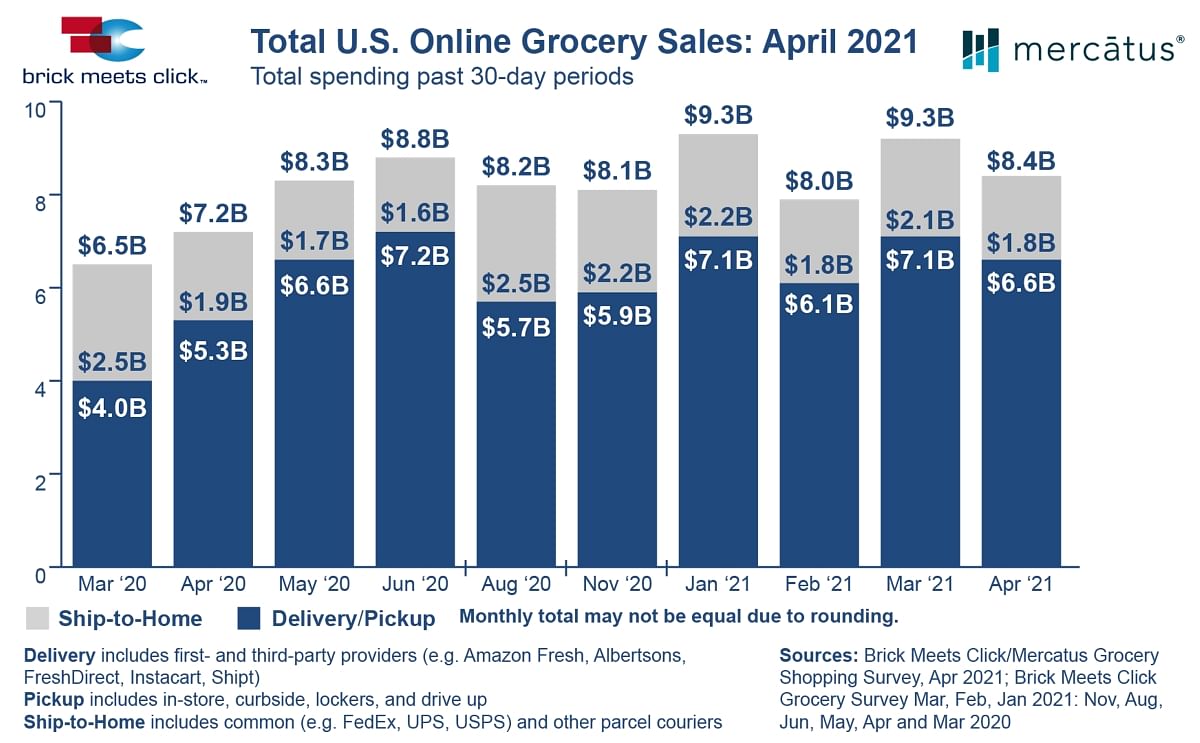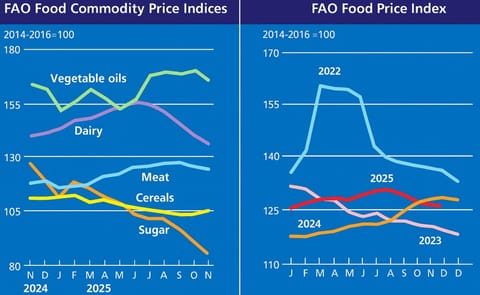The delivery/pickup segment captured $6.6 billion in sales, accounting for more than three-quarters of total online grocery sales for April.
US Online Grocery Sales hit USD8.4 billion in April, up 16% vs prior year

The US online grocery market finished April with $8.4 billion in sales, as 67.8 million households placed an average of 2.73 online grocery orders during the month, according to the Brick Meets Click/Mercatus Grocery Shopping Survey* fielded Apr. 26-28, 2021. The 16% jump in sales versus year ago, when sales were $7.2 billion, shows that to retain COVID-driven gains, retailers are now in a race to improve execution.
David Bishop, partner and research lead, Brick Meets Click:
According to the April 2021 Brick Meets Click/Mercatus Grocery Shopping Survey, the 16% growth in total online grocery sales of April ‘21 over the same period in April ‘20 reflects a mix of factors, and the ways that the pandemic has changed how people engage in online grocery shopping:
Slightly smaller base of engaged households
Monthly active users dropped 12% from 76.7 million in April 2020 to 67.8 million in April 2021. The respective monthly active user (MAU) bases for pickup and delivery both grew by more than 30% versus last year while the MAU ship-to-home base remained essentially flat. Pickup now has the largest user base of the three methods.
Higher order frequency
Monthly active users placed an average of 2.73 online orders during April 2021, up slightly from 2.68 orders a year ago. Year over year, the share of orders received via the ship-to-home segment dropped nearly 9 percentage points while pickup gained 6 percentage points and delivery picked up 3 percentage points.
More shoppers using multiple methods
A growing share of the monthly active user base relied on either two or three methods (pickup, delivery, and/or ship-to-home) to receive online grocery orders during April, continuing a trend that began at the onset of the pandemic in March 2020.
In April, over 35% of monthly active users received orders via more than one method, up almost 3 percentage points on a year-over-year basis and 20 points higher than pre-pandemic August 2019 levels.
AOVs drop, depending on the method
April 2021’s average order value (AOV) from pickup, delivery, and ship-to-home orders dropped 6% versus the prior year on an order-weighted basis.
The repeat intent rate, which measures the likelihood that a monthly active user will make another order within the next month with the same grocery service, jumped to 55% for April. This score is up 5 percentage points versus a year ago, but continues to remain significantly below pre-pandemic intent levels.
Among less satisfied users in April ‘21, 11% are still searching for an acceptable alternative as they are extremely or very likely to use another service in the next month.
About this Consumer Research
*The Brick Meets Click/Mercatus Grocery Shopping Survey is an ongoing independent research initiative created and conducted by Brick Meets Click and sponsored by Mercatus. Brick Meets Click conducted the survey on Apr. 26-28, 2021 with 1,941 adults, 18 years and older, who participated in the household’s grocery shopping.
Results were adjusted based on internet usage among U.S. adults to account for the non-response bias associated with online surveys. Responses are geographically representative of the U.S. and were weighted by age to reflect the national population of adults, 18 years and older, according to the U.S. Census Bureau.
David Bishop, partner and research lead, Brick Meets Click:
"Online shopping has remained an attractive way to buy groceries for a sizable segment of the U.S. Last year, retailers were in a race to meet the dramatic surge in demand; this year, it’s about executing a sound and sustainable strategy, with the imperative squarely on improving integration and implementation."The delivery/pickup segment captured $6.6 billion in sales, accounting for more than three-quarters of total online grocery sales for April.
Key Findings & Insights: April '20 vs '21
According to the April 2021 Brick Meets Click/Mercatus Grocery Shopping Survey, the 16% growth in total online grocery sales of April ‘21 over the same period in April ‘20 reflects a mix of factors, and the ways that the pandemic has changed how people engage in online grocery shopping:
Slightly smaller base of engaged households
Monthly active users dropped 12% from 76.7 million in April 2020 to 67.8 million in April 2021. The respective monthly active user (MAU) bases for pickup and delivery both grew by more than 30% versus last year while the MAU ship-to-home base remained essentially flat. Pickup now has the largest user base of the three methods.
Higher order frequency
Monthly active users placed an average of 2.73 online orders during April 2021, up slightly from 2.68 orders a year ago. Year over year, the share of orders received via the ship-to-home segment dropped nearly 9 percentage points while pickup gained 6 percentage points and delivery picked up 3 percentage points.
More shoppers using multiple methods
A growing share of the monthly active user base relied on either two or three methods (pickup, delivery, and/or ship-to-home) to receive online grocery orders during April, continuing a trend that began at the onset of the pandemic in March 2020.
In April, over 35% of monthly active users received orders via more than one method, up almost 3 percentage points on a year-over-year basis and 20 points higher than pre-pandemic August 2019 levels.
AOVs drop, depending on the method
April 2021’s average order value (AOV) from pickup, delivery, and ship-to-home orders dropped 6% versus the prior year on an order-weighted basis.
- This drop was driven largely by a 7% decline in ship-to-home’s AOV.
- Pickup and delivery AOVs dipped 1% and under 3% respectively and remain $8 (10%) above pre-COVID order values measured in August 2019.
The repeat intent rate, which measures the likelihood that a monthly active user will make another order within the next month with the same grocery service, jumped to 55% for April. This score is up 5 percentage points versus a year ago, but continues to remain significantly below pre-pandemic intent levels.
Among less satisfied users in April ‘21, 11% are still searching for an acceptable alternative as they are extremely or very likely to use another service in the next month.
About this Consumer Research
*The Brick Meets Click/Mercatus Grocery Shopping Survey is an ongoing independent research initiative created and conducted by Brick Meets Click and sponsored by Mercatus. Brick Meets Click conducted the survey on Apr. 26-28, 2021 with 1,941 adults, 18 years and older, who participated in the household’s grocery shopping.
Results were adjusted based on internet usage among U.S. adults to account for the non-response bias associated with online surveys. Responses are geographically representative of the U.S. and were weighted by age to reflect the national population of adults, 18 years and older, according to the U.S. Census Bureau.
Like to receive news like this by email? Join and Subscribe!
Get the latest potato industry news straight to your WhatsApp. Join the PotatoPro WhatsApp Community!
Sponsored Content
Sponsored Content
Sponsored Content
Sponsored Content










